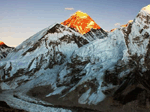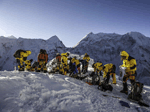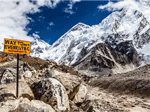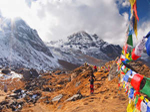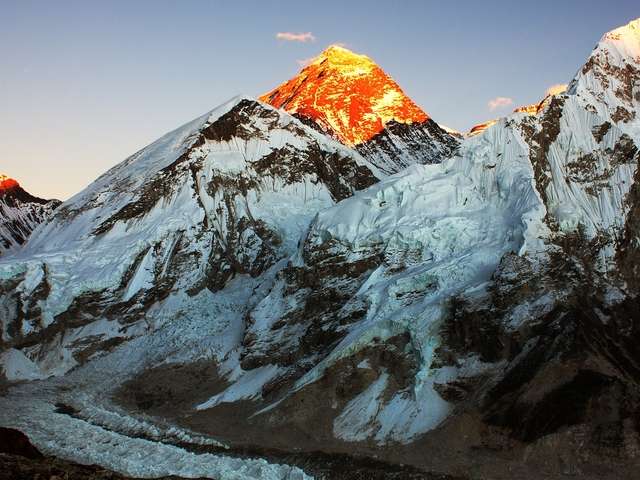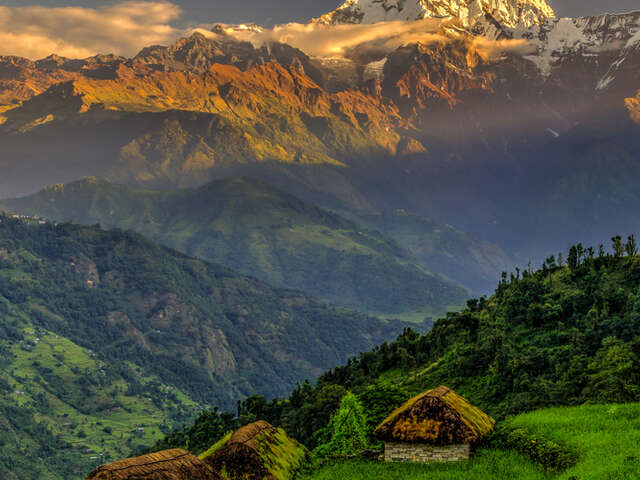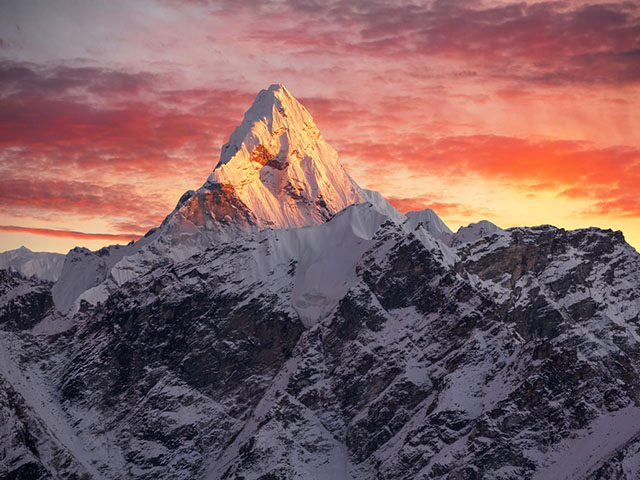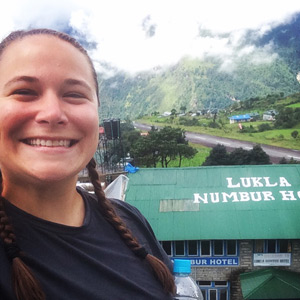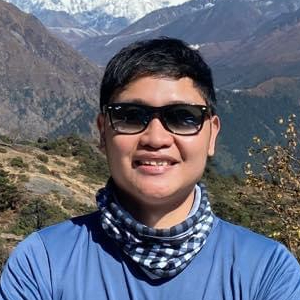
Training for Everest Base Camp should include improving cardio endurance, strength endurance, and being comfortable carrying a daypack uphill for long periods at a time. At least 8-12 weeks before your trek, you should begin hiking or taking long walks at least 1 day per week (focus on duration more than distance). You should build up to being able to walk or hike for 5-6 hours with minimal breaks.
If you don’t have significant hills or mountain terrain in your area walk hill intervals on a treadmill and stair stepper 2x per week. Most people will also benefit from completing full-body strength workouts twice per week.
You should always check in with your doctor before taking on a physical challenge like trekking Mount Everest Base Camp. You should also refer to your doctor before starting any training program.
Do I Need to Train for Everest Base Camp?
Whether or not you need to train for Everest Base Camp depends on your current physical condition. Most people will benefit from aerobic conditioning and strength endurance for Everest Base Camp. Although the trek is typically slow and steady, you will be trekking 5-8 hours per day and gaining on average 300m (1000 ft) in elevation each day. Taking a few long day hikes on hilly terrain can give you a good feel for whether or not you need to train for Everest Base Camp.
How to Train for Everest Base Camp
Training for Everest Base Camp should include aerobic conditioning, elevation training, and strength endurance training. While you can’t simulate the high altitude of Everest Base Camp, aerobic training will teach your body to work hard on less oxygen while elevation training will strengthen your muscles to better handle the elevation gain.
Many people picture the trek to Everest Base Camp as something like a marathon up the world’s tallest mountain, a physical challenge far beyond their ability. While the trek is tough, it is not nearly so bad as this. With the right attitude, the right pace, and some good preparation, trekkers young and old successfully reach Everest Base Camp and have a wonderful time along the way.
Getting yourself physically and mentally ready for your Everest Base Camp trek shouldn’t feel overwhelming. Don’t underestimate it, but you don’t need to be a marathon runner or top-grade athlete to make the trip. However, practice and preparation will make your trek much more enjoyable.

Everest Base Camp Training Option 1: Practice Hikes
The single best way to prepare for your Everest Base Camp trek is to get out hiking. Find some local trails, hike through your town, or just get out and walk. Get used to long walks. Learn where your body struggles and how far you can push yourself. You’ll be amazed at how far you can go once you get used to pushing through the first wave of discomfort.
Start small, build your endurance and step up the difficulty over time. Get to where you can walk for 5 or 6 hours with minimal breaks. Once you’ve done a few all-day hikes, you will have a good idea of how your body will react and how to manage an Everest Base Camp Trek.
Training Program (2X per week):
- Hike or take a long walk
- Build up to 5-6 hours with minimal rests
- Choose hilly, uneven terrain whenever possible
- Wear your daypack and slowly increase the weight of its contents to 25lbs over time

Everest Base Camp Training Option 2: Gym Workout
Trekking is a natural activity—it’s what the human body does best! You shouldn’t need a lot of dedicated strength training, but it is a good addition and can be very helpful if you can’t do practice hikes. You’ll be trekking and gaining elevation for several hours each day. Help your legs get ready by doing some strength training early.
If you don’t have access to good trails, here is a basic training program that will prepare you for Everest Base Camp using a treadmill and stair machine. If you don’t have access to these machines, a running track in the park or going around the neighborhood will work just as well.
Training Program (2X per week)
- 45 minutes on the treadmill hill setting at a walk or slow job
- 10 minutes stair-stepping machine for at a speed of 30-45 steps per minute
- 5 minutes slow walk with no incline to catch your breath
- Repeat 2-3X
Increase the time of each interval as you’re able. For additional strength training, adding 3 sets each of 30 lunges and squats to build those leg muscles. Watch your form, and make sure you’re stretching after!
Additional Tips for Training for Everest Base Camp
While you’re training for Everest Base Camp, consider the following tips to help make your training more effective.
Tip 1: Train in Conditions as Close to the Everest Base Camp as Possible
The best way to train for Everest base camp is to do your best to replicate the conditions as much as possible. This means wearing your hiking boots and daypack with a bit of weight in it, hiking for long distances, and practicing elevation gain and loss.
Tip 2: Get Your Gear Early
Get your trekking boots early and break them in! Whether you’re hiking on local trails or wearing them to the supermarket, you’ve got to get used to your boots. Pay attention to how your feet feel wearing them. You should have about a finger’s width of space between your toes and the end of the boot. If they’re pinching or rubbing after a few hours on the trail at home, it could be much worse after a few days on the trek.
The same goes for your daypack. Get it early and wear it on your practice hikes. Get used to the weight and learn how to adjust it to be more comfortable. Add a bit more weight as you get more practice. You’ll be glad you did—everything seems to weigh more after a few days on the trail and you’ll be far better prepared.
Tip 3: Do Cardio Training 2-3X per Week
Cardio workouts (walking, jogging, swimming, cycling) help train your body to work hard with less oxygen. This will help you keep your breath and focus at high elevation, and to enjoy the hike dramatically more.
Develop your cardio endurance with a simple workout 2-3 times a week, YouTube has many great options that can be done at home or on easy to find equipment. Build up difficulty and duration over time and remember why you’re training when you’re tired and want to stop early. You want to be basking in the views, not bent over struggling to catch your breath.
Tip 4: Give Yourself Enough Time to Prepare
You won’t get much benefit out of rushing your training in the few weeks before your trek. Start training for Everest Base Camp at least 8-12 weeks before your trek. We go slow and steady up the mountain—your training should do the same. Give your body plenty of time to adjust.
Tip 5: Watch Your Nutrition
As you step up your training you need to make sure you’re stepping up your nutrition too. You’ll use more calories and need more protein and nutrients to build muscle and stay healthy.
Tip 6: Learn a Few Stretches to Limber up Before and After a Day on the Trail
Having trekked many times, I can’t encourage this one enough. Get in the habit of adding 5-10 minutes of stretching to the end of your day on the trail. You’ll sleep better, and your body will thank you in the morning. Some dynamic stretches will warm you up in the morning and get you ready for the trail, and some static stretches will help loosen your muscles to heal as you’re resting at night. Here are some good recommendations for both dynamic (warm-up) and static (cool down) stretches.
Tip 7: Taper Off Before Your Trek
You don’t want to push yourself hard right before your trek. If you’ve started early, let your body rest up for a few days or a week before you get to Nepal. Stay active, keep stretching, but don’t train too hard. You want to arrive fresh and ready to hit the trail.
Final Thoughts on Training for Everest Base Camp
It’s important to put the Base Camp trek in perspective. It is a long route (over 120km round trip), but we’ll go slow and steady all the way. We lead the trek over 11 days: 8 days up, 3 down. You’ll spend 2 days on the way up resting and acclimating to the elevation, and most days have about 5-8 hours of trekking at a pretty reserved pace. We’ll gain about 300m (1000 feet) of elevation on average each day. We want to enjoy the views, and we have plenty of time. Slow and steady is the best way to safely enjoy the journey and minimize symptoms of elevation sickness.
It is important to understand that physical fitness does not guarantee you won’t be impacted by High Altitude Sickness. It will help you endure the challenges of the trek and enjoy your experience much more, but how your body adapts and responds to extreme elevation is only somewhat impacted by your physical fitness.

Bhagirathi Parbat Peak – Himalayan
This blog was originally published in July 2018 and was updated in January 2020.
